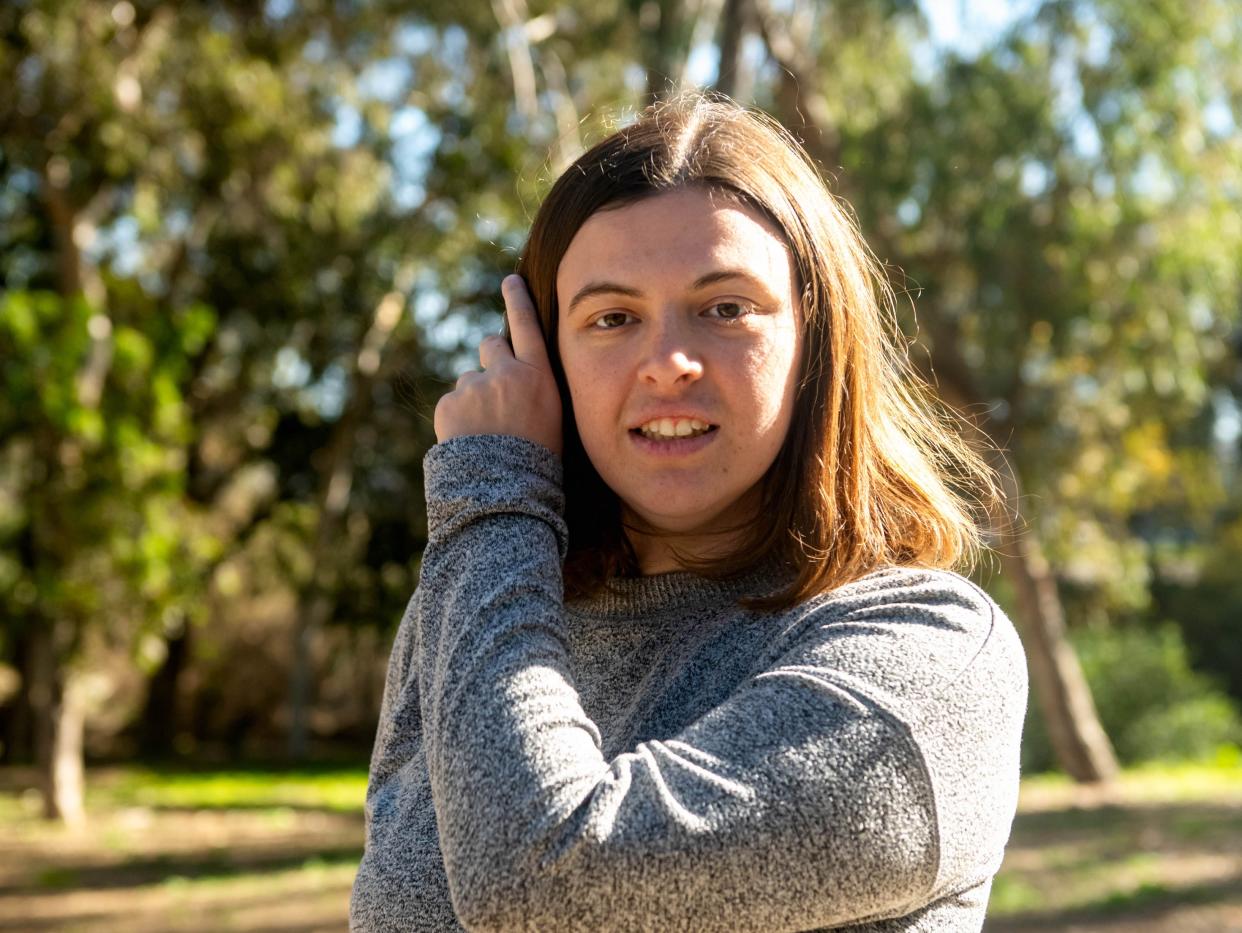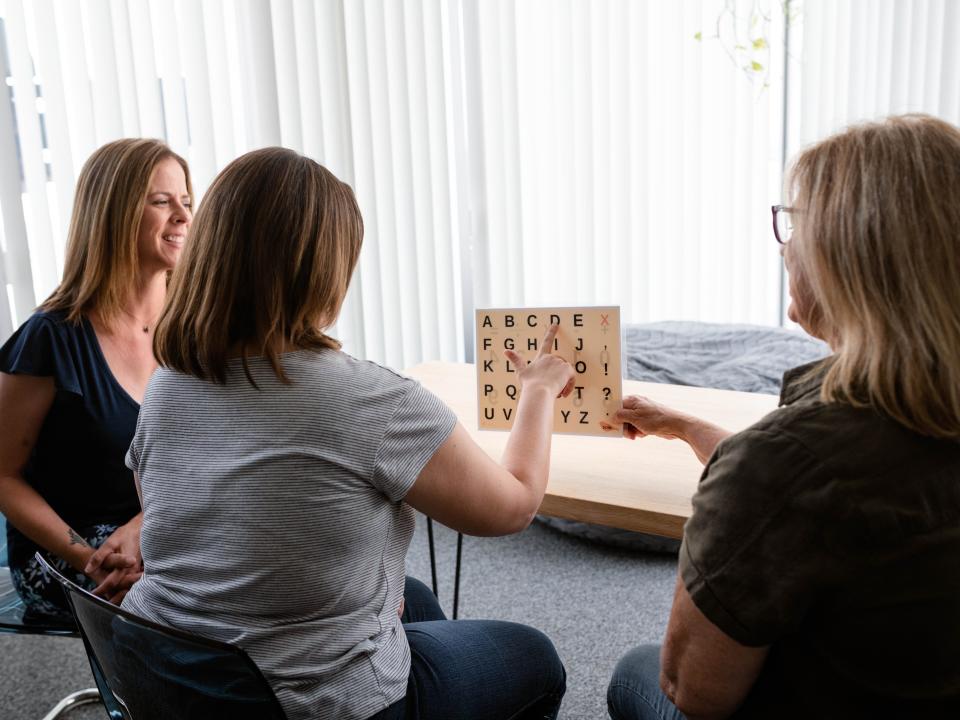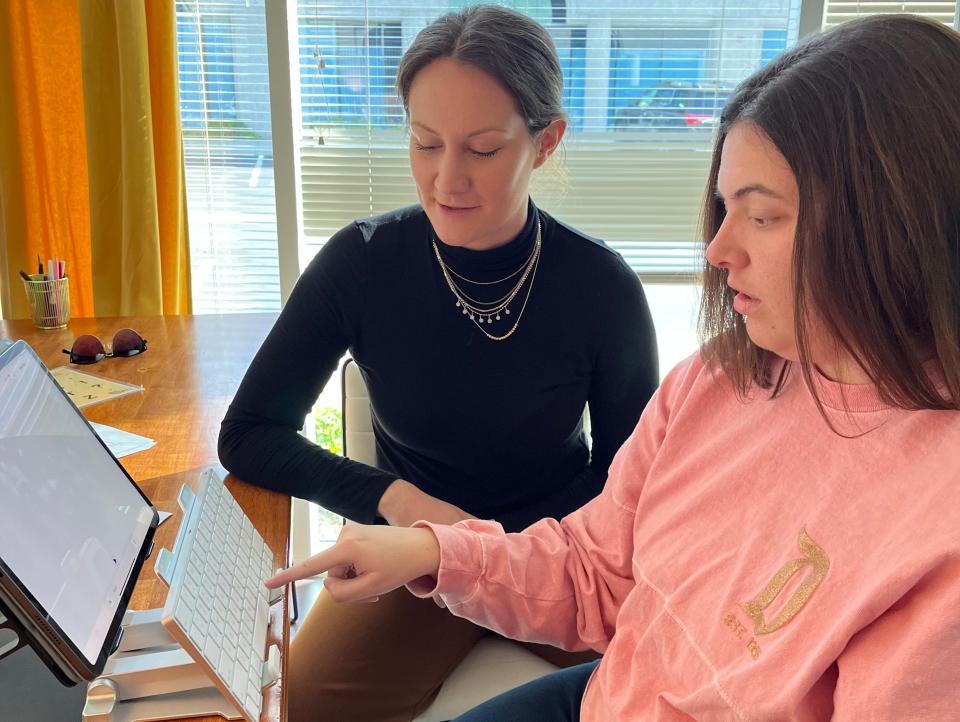A pointing technique could help nonverbal autistic people communicate. Many experts are skeptical.

Advocates of "spelling to communicate" claim it can help nonverbal people communicate with words.
Top-level experts have criticized the method and said the people are "cued" to point to the letters.
The producers of the new film "Spellers" want the practice to be taken seriously.
Two years ago, Madison Hollman, a nonverbal autistic person, wouldn't have been able to tell anyone that she was experiencing something like a toothache, her parents said. Madison would make involuntary noises such as grunts and hisses that they couldn't interpret and so had to guess what might be wrong, her parents told Insider.
But now the 25-year-old is able to communicate, the family said. Her mom, Linda Hollman, told Insider that on a recent visit to the dentist, Madison purposefully pointed at letters of the alphabet stenciled on a laminated board that was held in front of her face. She spelled out the words, "I have pain in the back of my mouth" — a sentence that her mom, who was holding the board, spoke aloud.
It turned out that her daughter needed to have her wisdom teeth removed, Linda Hollman said.
"We were obviously concerned that Madison required the surgery," Hollman, of Orange County, California, said. "But we were thrilled that she was able to make those needs understood."
The Hollmans attribute the "life-changing" breakthrough to a revolutionary — and disputed — method called spelling to communicate, also known as S2C. The technique is the subject of a new documentary, "Spellers," a film that focuses on eight nonverbal autistic people, including Madison Hollman, who are said to have learned to communicate this way. The first variation of the technique was known as the rapid prompting method, created by Soma Mukhopadhyay, an Indian educator who developed the method after using it with her autistic son in the 1990s.
Later, Elizabeth Vosseller, a speech-language pathologist and former assistant professor at George Washington University, created spelling to communicate, a model similar to the rapid prompting method. Since its establishment in 2019, her nonprofit, the International Association for Spelling as Communication, has registered 350 practitioners in 35 American states and 15 countries.
Proponents include the businessman J.B Handley, who founded the controversial website Generation Rescue, which supports the scientifically unproven link between autism and immunizations. "Spellers" was inspired by Handley's 2021 book, "Underestimated: An Autism Miracle," in which Handy claims that spelling to communicate finally allowed his nonverbal autistic son, Jamison, the ability to be understood.
Handley and the other supporters of S2C believe that apraxia — a common disorder among autistic people that affects the part of the brain responsible for producing speech — can be treated by improving the motor skills needed to coordinate the brain and the body.

"Moving your lips, your tongue, and your jaw requires a lot of fine motor coordination, which is difficult for folks with apraxia," said Dawnmarie Gaivin, a registered nurse and S2C practitioner who cofounded Spellers Method, a company that teaches the technique. Gaivin, who is Madison Hollman's tutor, has two nonverbal sons on the spectrum and is featured extensively in "Spellers."
The answer to the fine motor issues, Gaivin said, is to encourage people to use the gross motor skills of their shoulder and arm to point at letters stenciled alphabetically on a board the size of a placemat. One source of contention around the method is that the board has to be held directly in front of a student's face by a professional or parent trained in the practice, which speech-language-hearing experts have said doesn't allow for independent communication.
Experts at the American Speech-Language-Hearing Association do not recommend the spelling to communicate method.
"It's just another name for the rapid prompting method," Diane Paul, the senior director for clinical issues in speech-language pathology at the organization, told Insider. Five years ago, the group, which has 280,000 professional members, released a position paper questioning its validity.
The organization says that the words autistic people seem to be spelling by using the technique "should not be assumed to be the communication of the person with a disability" and that practitioners could be dictating the words by directing the person toward certain letters.
Hollman said her daughter and others were 'underestimated'
Gaivin and the parents featured in "Spellers" say their children were pushed to the margins of society because of their inability to talk and the false assumption that they were cognitively disabled.
"They couldn't prove their comprehension because they'd have to speak, point to, or use some other way to demonstrate it," Gaivin told Insider.
The advocates of S2C featured in the documentary said the young adults were only able to share their knowledge, opinions, and feelings after being taught how to spell on letter boards.
"It proves that they were all underestimated," Linda Hollman said.
She said that something as seemingly trivial as having a dish ordered on your behalf at a restaurant could be a source of frustration for nonverbal autistic people. "One family would always order a chicken bowl for their kid at Chipotle because they thought it was his favorite," Hollman said. "Before S2C, he couldn't tell them that he wanted a steak bowl instead."

Linda Hollman told Insider that Madison's teachers insisted she had the intelligence of a toddler when she was 8 years old. But Hollman said Madison was "completely underestimated" because of her inability to speak. Therapists assumed that Madison couldn't read because she couldn't demonstrate her aptitude by talking or writing letters like other kids, she said.
Linda Hollman said that until she signed Madison up for an S2C class in 2020, she too had "misunderstood" her daughter "from the moment she was diagnosed with autism" at 3 years old. It took Madison weeks to work on her coordination and gross motor skills so she could hold her tutor Gaivin's pencil and jab it at the stenciled letters to spell words.
Hollman said closed captioning on TV helped her daughter read — but she had no idea at the time
Linda Hollman said the classes — which cost $100 an hour in 2020 and are now $150 an hour — initially focused on the topic of American history, including the life of Benjamin Franklin. "One day, Maddie spelled out 'harbinger' in relation to Benjamin Franklin," she said. "I was stunned because I didn't know what the word meant myself!"
"Maddie's first open thought that she spelled was, 'Most poorly talking individuals are not seen as thinking people,'" Hollman said she wept with joy as her child gained the confidence to spell in front of family and friends.
"She became fluent," Linda Hollman said. "We got to know her at last."
Madison told her parents that she owed her spelling proficiency in part to closed captioning on TV as she grew up, Linda Hollman said, and the family had no idea that Madison had been reading along when they watched shows together. Madison later asked for a math tutor, her mom said, saying she'd "missed out on a 'real' education" like her sisters.

Madison has since graduated from spelling on the letter board to using a keyboard that she types on with one finger. It needs to be tilted in the same way as the letter board. She lacks confidence and still needs someone to sit with her while she spells. Still, her goal is to become independent enough to do without their presence.
This year, she enrolled in online university courses to study genealogy. One tutor asked her to write a short autobiography which she shared with Insider. "I began to believe that I would never have a say in my daily life," Madison wrote about her former isolation. "Spelling to communicate changed my life," she continued, "I was finally set free from my prison of silence."
Madison recalled how she'd "appeared unintelligent to most everyone because my body was not regulated." She added, "I began to believe that I would never have a say in my life."
Linda Hollman told Insider that she was skeptical at first about S2C because so many other forms of speech therapy had "failed" her daughter.
The spelling to communicate method is controversial
Paul from ASHA told Insider that while the group "absolutely supports augmentative and alternative communication," it questions the validity of spelling to communicate.
"We support the use of letter boards, keyboards, spelling, and typing 100%," Paul said. "Our concern is the prompt dependence. With the rapid prompting method, the letter board is held up in the air by someone else, and it can be moved around even slightly to influence the person who's doing the communicating."

She suggested the letter board should simply be placed on a table.
"Every person with autism does not have a motor disability, and that argument has not been verified," Paul said. "The same fine motor skill that is used for pointing at the alphabet on a table is used for pointing at a letter board held in the air."
In 2020, Nature published a small study that gave merit to the spelling to communicate method. The researchers wrote in the abstract that their "findings render a cueing account of participants' performance unlikely." The study aimed to establish whether S2C students may have been "directed" to select certain letters by the assistant who held the letterboard in front of them.
The researchers placed head-mounted eye-tracking devices on nine students to test how much agency they had over their attempts to communicate. They measured the speed and accuracy with which the participants looked at and pointed to letters when they answered a new, unrehearsed set of 24 questions about an article that was read aloud to them.
"Each pointed to about one letter per second, rarely made spelling errors, and visually fixated most letters about half a second before pointing to them," the psychology research team from the University of Virginia, Charlottesville, wrote. It said the students' response times reflected the planning and production processes that characterized fluent spelling by typists who were neurotypical.
"The speed, accuracy, timing, and visual fixation patterns suggest that participants pointed to letters they selected themselves, not letters they were directed to by the assistant," the extract said, concluding, "The blanket dismissal of assisted autistic communication is therefore unwarranted."
Linda Hollman said her daughter's remarkable progress proves the point: "Spelling to communicate opened up Maddie's whole world."
Read the original article on Insider


